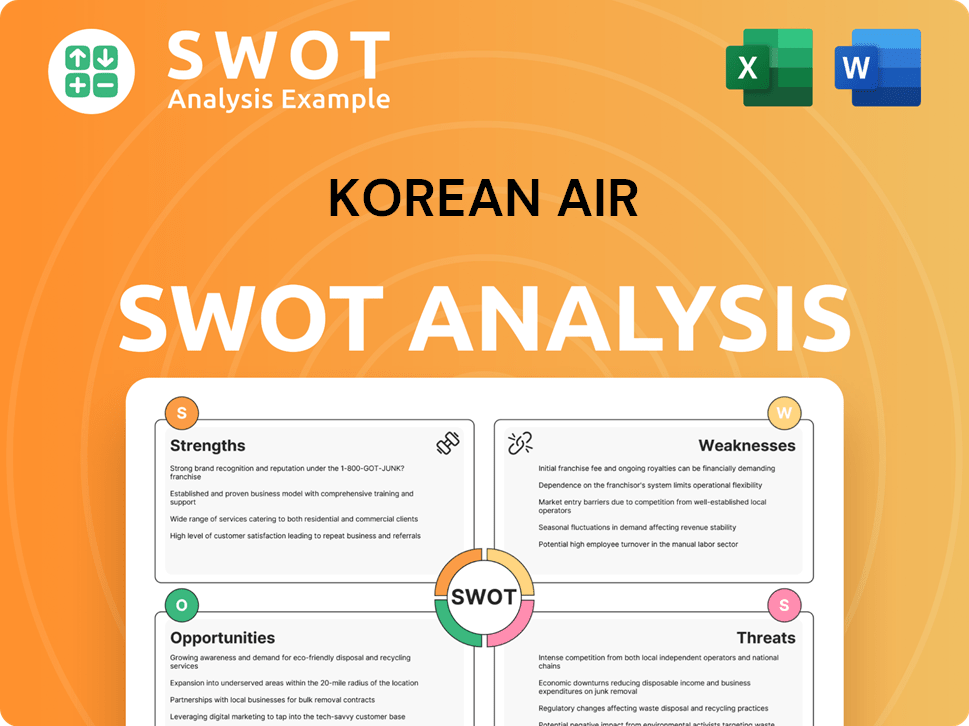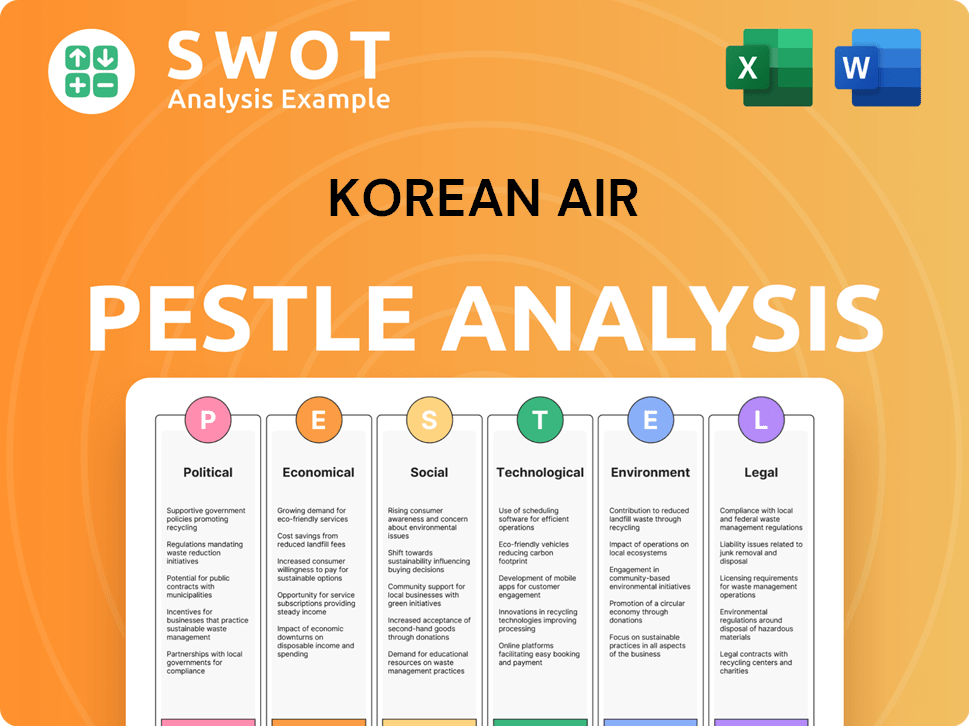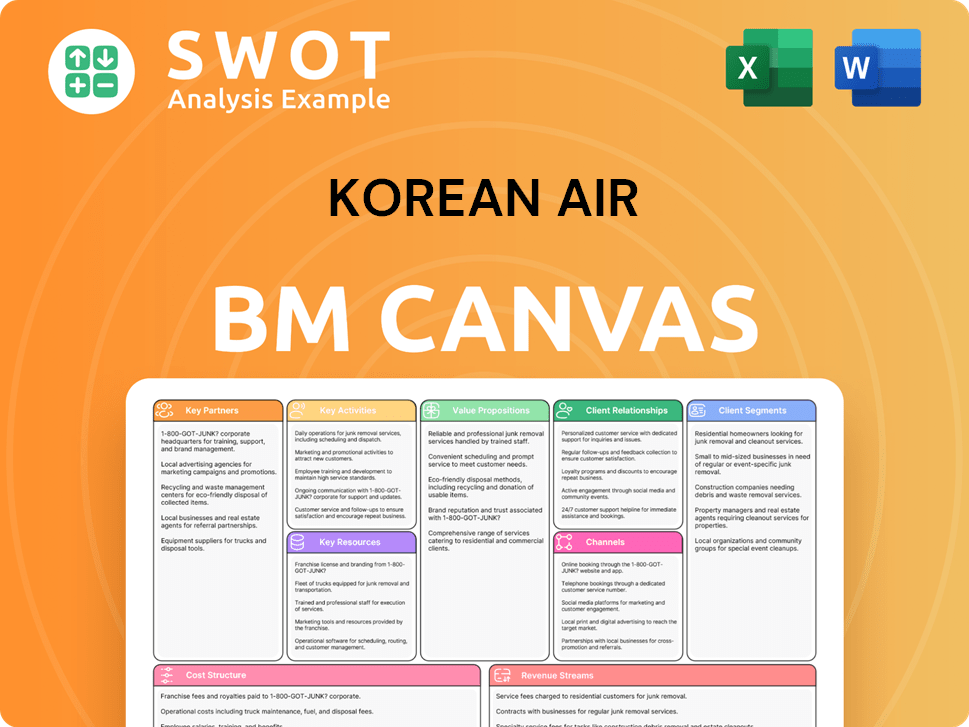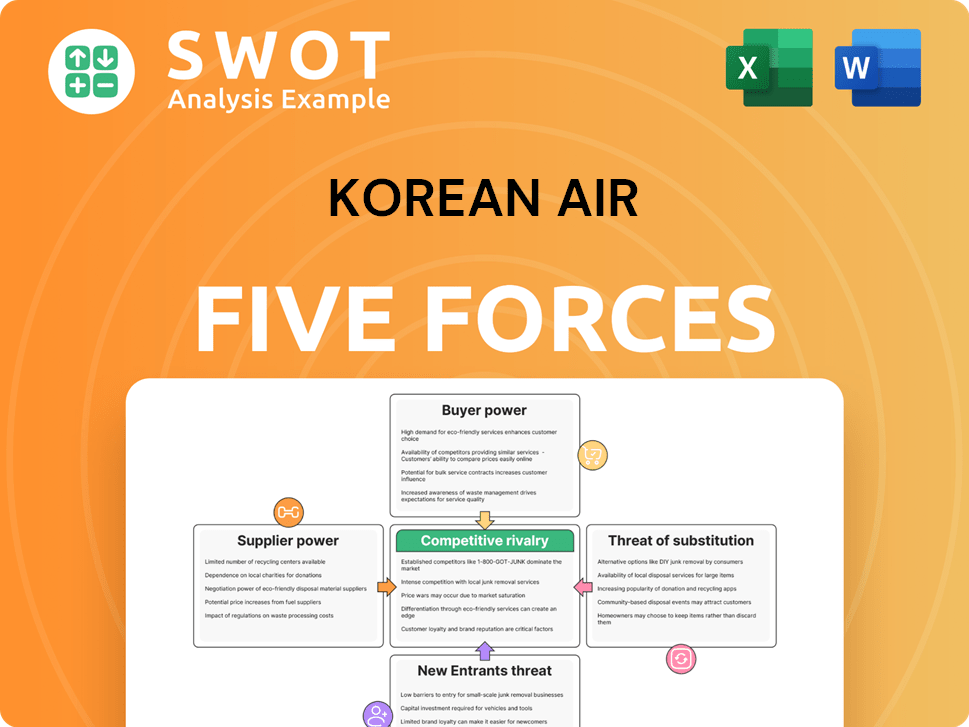Korean Air Bundle
Can Korean Air Soar to New Heights Post-Merger?
Following its landmark acquisition of Asiana Airlines in late 2024, Korean Air is poised to redefine the aviation industry. This strategic move not only reshapes the South Korean aviation landscape but also positions Korean Air to become a global aviation powerhouse. The integration, slated for completion by early 2027, marks a critical juncture for the airline's future.

This analysis delves into Korean Air's ambitious Korean Air SWOT Analysis, exploring its growth strategy and future prospects in a dynamic market. We'll dissect the airline's expansion plans, examining its potential for increased Korean Air market share and improved financial performance. Furthermore, the discussion will cover Korean Air's strategic initiatives and the impact of the merger on its long-term business outlook, including the challenges and opportunities ahead for the company.
How Is Korean Air Expanding Its Reach?
The core of the Korean Air growth strategy revolves around the acquisition and integration of Asiana Airlines, finalized in December 2024. This strategic move is designed to significantly broaden its operational scope. The merger aims to position the combined entity among the top airlines globally.
The integration of Asiana Airlines, which will operate as a subsidiary until January 2027, is central to Korean Air's expansion plans. This merger is expected to streamline routes and explore new destinations. The goal is to reinforce Seoul's Incheon Airport as a major international hub.
Korean Air's future prospects are also shaped by its commitment to fleet modernization and route expansion. These initiatives, combined with strategic mergers, are key to the airline's long-term growth and market position.
The merger, completed in December 2024, is a pivotal element of Korean Air's growth strategy. Asiana Airlines will function as a subsidiary until the integration is completed in January 2027. The Asiana Airlines brand will be phased out by the end of 2026.
Korean Air is actively expanding its exclusive international routes. As of May 2025, the airline operated 34 exclusive international routes. The combined entity will offer 76 exclusive routes. Recent additions include routes from Incheon to Kobe, the Incheon-Nagasaki route (relaunched in October 2024), and a new connection to Lisbon.
The airline is investing in fleet modernization with firm orders for 20 Boeing 777-9s and 20 Boeing 787-10s, and options for ten additional aircraft. This deal is valued at over $32.7 billion, with deliveries expected by 2033. Additionally, Korean Air ordered 33 A350 family aircraft from Airbus in April 2024, receiving its first A350-900s in December.
In response to growing market demand, Korean Air will introduce premium-economy seating in 2025, retrofitting 11 Boeing 777-300 ER aircraft. The first retrofitted plane is expected to enter service in the second half of 2025. This initiative aims to enhance passenger experience and cater to a wider range of customer preferences.
Korean Air plans to expand and renovate its lounges at Incheon International Airport Terminal 2. The expansion will double seating capacity and increase lounge space by 2.5 times by April 2026. This investment aims to improve passenger comfort and enhance the overall travel experience.
- The merger with Asiana Airlines is a key strategic move.
- Fleet modernization with new aircraft orders is underway.
- Introduction of premium economy seating is planned for 2025.
- Expansion of lounges at Incheon Airport is scheduled.
Korean Air SWOT Analysis
- Complete SWOT Breakdown
- Fully Customizable
- Editable in Excel & Word
- Professional Formatting
- Investor-Ready Format

How Does Korean Air Invest in Innovation?
The airline's growth strategy heavily relies on innovation and technology to enhance operational efficiency, improve customer service, and promote sustainability. This approach is crucial for navigating the competitive landscape and achieving long-term success. The company's future prospects are closely tied to its ability to adapt and integrate advanced technologies across its operations.
Digital transformation and the adoption of cutting-edge technologies are central to the company's strategic initiatives. These efforts aim to streamline processes, reduce costs, and improve the overall travel experience for passengers. The company's focus on technology reflects a broader industry trend toward digitalization and automation.
The company's strategic initiatives for 2024 and beyond demonstrate a commitment to leveraging technology for growth and sustainability. This includes investments in AI, automation, and sustainable aviation fuel, positioning the company for future success. A comprehensive Marketing Strategy of Korean Air highlights how these efforts are integrated into their broader business objectives.
The airline is building an AI-powered contact center (AICC) in partnership with Amazon Web Services (AWS). This cloud-based platform will use AI to power voice bots and chatbots, improving customer service personalization and efficiency.
The goal is to consolidate the existing call center infrastructure into a single AWS platform by September 2024. This consolidation aims to streamline operations and improve service delivery.
The company plans to integrate machine learning and generative AI by February 2025. This integration will further enhance customer service capabilities and operational efficiency.
The airline is focusing on the digitalization and automation of logistics within its cargo operations. This includes developing advanced smart terminals to improve efficiency.
The company is collaborating with airport authorities, government entities, and partners to develop an advanced smart terminal. This initiative aims to enhance work efficiency and customer convenience.
Extending direct customer interactions via APIs is a key component of the smart terminal project. This will improve the overall customer experience and streamline processes.
Sustainability is a key aspect of the airline's long-term strategy. The company is actively implementing initiatives to reduce its environmental impact and promote sustainable practices. These efforts are crucial for long-term business outlook and align with global trends.
- Sustainable Aviation Fuel (SAF) Usage: Starting August 30, 2024, the company is implementing a 1% Sustainable Aviation Fuel (SAF) blend for its weekly flight KE719 from Seoul Incheon to Tokyo Narita. This initiative marks the first time a Korean flag carrier has used domestically produced SAF in commercial flights, with plans to expand SAF usage across medium and long-haul routes.
- Fleet Modernization: The company is continually upgrading its fleet with next-generation aircraft models, such as the Airbus A220-300, A321-neo, Boeing 787-9, 787-10, and 737-8. These aircraft offer 20-25% lower carbon emissions per seat, contributing significantly to the airline's sustainability goals.
- Environmental Goals: The airline aims to achieve net-zero carbon emissions by 2050, demonstrating a strong commitment to reducing its carbon footprint. This goal is supported by investments in sustainable technologies and operational efficiencies.
- Impact of Fuel Prices: The company's financial performance is significantly impacted by fuel prices. The adoption of SAF and more fuel-efficient aircraft helps mitigate the effects of fluctuating fuel costs.
Korean Air PESTLE Analysis
- Covers All 6 PESTLE Categories
- No Research Needed – Save Hours of Work
- Built by Experts, Trusted by Consultants
- Instant Download, Ready to Use
- 100% Editable, Fully Customizable

What Is Korean Air’s Growth Forecast?
In 2024, Korean Air's financial performance demonstrated robust growth, with record-high revenue and significant increases in operating profit. This performance underscores the effectiveness of the airline's strategic initiatives and its ability to capitalize on market opportunities. The company's focus on both passenger and cargo operations has been key to its success, positioning it well for future growth.
The airline's financial results for 2024 showed a strong recovery, driven by increased demand in both passenger and cargo segments. The airline's ability to adapt to changing market conditions and manage its capacity effectively contributed to its positive financial outcomes. The company's expansion plans and strategic investments are expected to further enhance its market position and drive sustainable growth.
Looking ahead to Q1 2025, Korean Air anticipates continued growth, aiming to maximize revenue in passenger operations by maintaining capacity on high-demand routes and expanding charter flights. The cargo division is set to strengthen profitability through service diversification and dynamic capacity management. These strategies are designed to navigate the uncertainties in the global political landscape and solidify the airline's position as a leading global carrier.
Korean Air reported a record-high revenue of KRW 16.1166 trillion (USD 10.9637 billion) in 2024. The operating profit reached KRW 1.9946 trillion (USD 1.3229 billion).
The airline experienced a 10.6% year-on-year increase in revenue and a 22.5% increase in operating profit in 2024.
In Q1 2025, revenue increased by 3% year-on-year, reaching KRW 3.96 trillion (approximately USD 2.7 billion).
The cargo division posted revenues of KRW 1.05 trillion in Q1 2025, a 6% rise compared to Q1 2024.
Korean Air is focusing on several key strategies to ensure sustained growth. These include maximizing revenue in passenger operations by maintaining capacity on high-demand routes and expanding charter flights, and strengthening cargo operations through service diversification and dynamic capacity management. The company is also strategically preparing for the integration with Asiana Airlines.
- Acquisition of Asiana Airlines: A 63.88% stake was acquired for 1.5 trillion Korean won (US$1.05 billion).
- Cargo Operations: Leveraging e-commerce, electronics, automotive parts, and Korean exports to drive revenue.
- Market Expansion: Anticipating sustained long-haul demand and recovery in the China market.
Korean Air Business Model Canvas
- Complete 9-Block Business Model Canvas
- Effortlessly Communicate Your Business Strategy
- Investor-Ready BMC Format
- 100% Editable and Customizable
- Clear and Structured Layout

What Risks Could Slow Korean Air’s Growth?
The path ahead for Korean Air, including its Korean Air growth strategy and future prospects, is fraught with potential risks and obstacles. These challenges span market competition, regulatory hurdles, operational complexities, and economic pressures. Successfully navigating these issues is crucial for the airline to achieve its expansion plans and maintain a strong Korean Air market share.
One of the primary concerns for Korean Air company analysis involves the integration of Asiana Airlines. While the merger, finalized in December 2024 after approvals from 14 regulatory bodies, including the US Department of Justice, promises growth, it also introduces significant operational complexities. The integration of IT systems alone requires migrating data into 154 of Korean Air's systems. The airline must also contend with supply chain vulnerabilities, particularly aircraft delivery delays, and rising operational costs, including fuel and labor.
To mitigate these risks, Korean Air is implementing strategic adjustments. These include optimizing fleet utilization, consolidating operations at major hubs, and making agile capacity adjustments in cargo operations. The airline also actively manages environmental risks, demonstrating a commitment to sustainability. For a deeper understanding of the company's foundational principles, consider reviewing the Mission, Vision & Core Values of Korean Air.
Intense competition in the global aviation market requires Korean Air to continuously differentiate itself. This involves offering competitive pricing, superior customer service, and innovative routes to maintain and increase its Korean Air market share. The airline faces competition from both established and emerging carriers, making it essential to adapt quickly to market changes.
Regulatory approvals, especially those related to the merger with Asiana Airlines, have posed significant hurdles. While the merger was finalized in December 2024, obtaining approvals involved navigating complex antitrust regulations and making concessions, such as divesting the Asiana cargo unit. Future expansion plans may face similar regulatory scrutiny.
Integrating Asiana Airlines presents numerous operational challenges, including standardizing IT systems and migrating data. Supply chain disruptions and aircraft delivery delays, which have forced the airline to scale back operations on certain routes and keep older aircraft flying, add to these complexities. For example, international flights from regional airports saw a 45% decrease from 2019 to 2024.
Delays in aircraft deliveries from manufacturers have a direct impact on Korean Air's fleet modernization program and its ability to expand its Korean Air route network expansion strategy. These delays require adjustments to flight schedules and fleet management, affecting operational efficiency and potentially impacting Korean Air passenger traffic forecasts. Approximately 40% of Korean Air's A220-300 fleet has been grounded due to engine problems.
Increasing fuel prices and labor costs pose significant financial challenges to the airline's Korean Air financial performance. These costs can erode profit margins and require careful financial management and strategic adjustments. Managing these costs effectively is crucial for maintaining Korean Air profitability analysis.
The aviation industry faces increasing pressure to reduce its environmental impact. Korean Air must manage risks related to chemical use, air and water pollution, aircraft noise, and biodiversity impacts. Implementing Korean Air sustainable aviation fuel initiatives and other environmental measures are essential for long-term sustainability and compliance with regulations.
Optimizing fleet utilization and consolidating operations at major hubs, like Incheon, are key strategies. The airline's strategic shift to focus on more profitable long-haul routes, while addressing supply chain delays, is also crucial. For example, international flights from regional airports saw a 36% drop in the first quarter of 2025 compared to the same period in 2019.
Actively managing operational costs, particularly fuel and labor expenses, is essential. This includes hedging fuel prices, negotiating favorable labor contracts, and improving overall operational efficiency. These actions directly impact the Korean Air long-term business outlook and Korean Air profitability analysis.
Korean Air Porter's Five Forces Analysis
- Covers All 5 Competitive Forces in Detail
- Structured for Consultants, Students, and Founders
- 100% Editable in Microsoft Word & Excel
- Instant Digital Download – Use Immediately
- Compatible with Mac & PC – Fully Unlocked

Related Blogs
- What are Mission Vision & Core Values of Korean Air Company?
- What is Competitive Landscape of Korean Air Company?
- How Does Korean Air Company Work?
- What is Sales and Marketing Strategy of Korean Air Company?
- What is Brief History of Korean Air Company?
- Who Owns Korean Air Company?
- What is Customer Demographics and Target Market of Korean Air Company?
Disclaimer
All information, articles, and product details provided on this website are for general informational and educational purposes only. We do not claim any ownership over, nor do we intend to infringe upon, any trademarks, copyrights, logos, brand names, or other intellectual property mentioned or depicted on this site. Such intellectual property remains the property of its respective owners, and any references here are made solely for identification or informational purposes, without implying any affiliation, endorsement, or partnership.
We make no representations or warranties, express or implied, regarding the accuracy, completeness, or suitability of any content or products presented. Nothing on this website should be construed as legal, tax, investment, financial, medical, or other professional advice. In addition, no part of this site—including articles or product references—constitutes a solicitation, recommendation, endorsement, advertisement, or offer to buy or sell any securities, franchises, or other financial instruments, particularly in jurisdictions where such activity would be unlawful.
All content is of a general nature and may not address the specific circumstances of any individual or entity. It is not a substitute for professional advice or services. Any actions you take based on the information provided here are strictly at your own risk. You accept full responsibility for any decisions or outcomes arising from your use of this website and agree to release us from any liability in connection with your use of, or reliance upon, the content or products found herein.